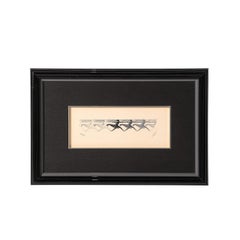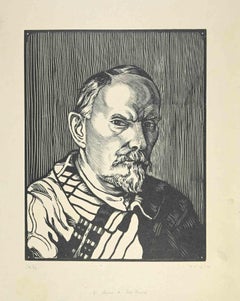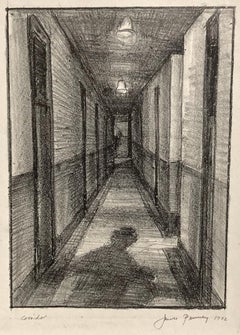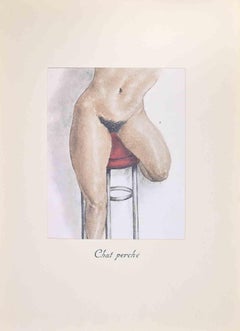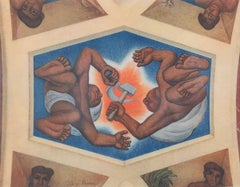1930s Figurative Prints
to
211
958
136
48
25
28
Overall Width
to
Overall Height
to
639
43
41
33
28
22
8
8
2
83
34
27
25
25
3,640
7,752
25,291
6,688
285
583
1,456
1,207
1,251
2,190
3,045
5,173
3,023
1,521
3,108
864
323
6
912
484
475
363
306
243
184
108
88
74
63
62
56
37
33
33
30
26
24
23
465
410
204
90
79
69
468
582
436
Period: 1930s
Art Deco Serigraph entitled Dancers by Erté
By Erté
Located in New York, NY
This striking serigraph by Erté (Romain de Tirtoff) exemplifies the elegance and fluidity of the Art Deco style. Known for his iconic depictions of movement and couture, Erté capture...
Category
Art Deco 1930s Figurative Prints
Materials
Black and White
Portrait of Jules Lenard - Woodcut by Paul Emile Colin - 1930 ca.
Located in Roma, IT
Woodcut print realized by Paul Emile Colin in the 1930s.
Edition of 30/35.
Hand signed and numbered.
Very good condition.
Category
Modern 1930s Figurative Prints
Materials
ABS, Woodcut
James Penney, Corridor
By James Penney
Located in New York, NY
James Penney was widely known for his New Yorker covers as well as his paintings and prints.
Penney was from Saint Joseph, Missouri. He trained in NY...
Category
Ashcan School 1930s Figurative Prints
Materials
Lithograph
$720 Sale Price
20% Off
Chat Perché - Lithograph by Edouard Chimot - 1932
Located in Roma, IT
Lithograph realized by Edouard Chimot in 1932.
Belongs to the suite "Le Chat", in which the author classifies and represents pubic hairstyles that become progressively more surreal....
Category
Post-Impressionist 1930s Figurative Prints
Materials
Lithograph
ASTOR LOBBY, SHOWTIME
By Don Freeman
Located in Portland, ME
Freeman, Don (American, 1908-1978). ASTOR LOBBY,SHOWTIME. McCulloch 34. Lithograph, 1932. Edition of 30 or fewer. Signed in pencil lower right. 8 7/8 x 11 1/8, 225 x 283 mm.(image), ...
Category
1930s Figurative Prints
Materials
Lithograph
Chapel of the Agricultural School, Chapingo (Ceiling Detail, Workers)
Located in Missouri, MO
(after) Diego Rivera
"Chapel of the Agricultural School, Chapingo" (Ceiling Detail, Workers) 1933
from the portfolio "Frescoes of Diego Rivera"
Published by the Museum of Modern Art, NY
Size with the Matt: 18.5 x 13.5 inches
Hand-Signed by the Artist
Diego Rivera was born on December 13, 1886 in the mountain town of Guanajuato in Mexico. His mother was an ardent Catholic and his father was a rich and aristocratic revolutionary fighter and an atheist. Little Diego decided in favor of atheism. He swore his family had to leave Guanajuato when he was six because of his diatribes against the Church. When he was eleven he attended the San Carlos Academy of Fine Arts; his real teacher was Jose Posada...
Category
Modern 1930s Figurative Prints
Materials
Lithograph
Polyxène, Fille de Priam, est égorgée sur la Tombe d'Achille
Located in Roma, IT
Original etching from the portfolio "Les Métamorphoses d'Ovide" realized by Pablo Picasso in 1930 and published by Skira. Edition of 145 copies.
Very good conditions.
Re. Bloch p....
Category
Modern 1930s Figurative Prints
Materials
Etching
Jean Cocteau, Untitled, from The White Book, 1930
By Jean Cocteau
Located in Southampton, NY
This exquisite lithograph and pochoir with hand coloring by Jean Cocteau (1889–1963), titled Sans titre (Untitled), from the album Le Livre blanc (The White Book), precede dun frontispice et accompagne de 17 dessins de Jean Cocteau (preceded by a frontispiece and accompanied by 17 drawings by Jean Cocteau), originates from the 1930 edition published by Editions du Signe, Paris, printed by Maitres-Imprimeurs, Ducros et Colas, Paris, and hand colored by M.B. Armington (a probable pseudonym of Jean Cocteau), May 10, 1930. The work reflects Cocteaus mastery of linear elegance and psychological nuance, distilling intimacy, vulnerability, and symbolic clarity into a composition that occupies a pivotal place in early twentieth-century modernism and queer cultural history.
Executed as a lithograph and pochoir with hand coloring on velin d'Arches paper, this work measures 11.81 x 9.06 inches. Unsigned and unnumbered, as issued. The edition exemplifies the refined craftsmanship of Ducros and Colas, Maitres-Imprimeurs, and the exceptional hand-coloring attributed to Cocteau himself.
ARTWORK DETAILS
Artist: After Jean Cocteau (1889–1963)
Title: Sans titre (Untitled), from the album Le Livre blanc (The White Book), precede dun frontispice et accompagne de 17 dessins de Jean Cocteau (preceded by a frontispiece and accompanied by 17 drawings by Jean Cocteau)
Year: 1930
Medium: Lithograph and pochoir with hand coloring on velin d'Arches paper
Size: 11.81 x 9.06 inches
Inscription: Unsigned and unnumbered, as issued
Publisher: Editions du Signe, Paris
Printer: Maitres-Imprimeurs, Ducros et Colas, Paris
Catalogue Raisonne References:
Bezit, Emmanuel. Dictionnaire Critique et Documentaire des Peintres, Sculpteurs, Dessinateurs et Graveurs. Gründ, 1976, vol. 3, p. 744.
Carteret, Leon. Le Tresor du Bibliophile: Livres Illustres Modernes, 1875–1945. Editions Carteret, 1958, vol. 5, p. 51.
van der Veen, H. In Liefde Verzameld: Homoseksualiteit en de Nederlandse Literatuur. De Buitenkant, 1992, no. 136.
Monod, Luc. Manuel de Lamateur de Livres Illustres Modernes: 1875–1975. Ides & Calendes, 1992, no. 2912.
Condition: Well preserved, consistent with age and medium
Provenance: From the album Le Livre blanc, published by Editions du Signe, Paris; printed by Ducros et Colas, Paris; hand colored by M.B. Armington (a probable pseudonym of Jean Cocteau), May 10, 1930
NOTES
Excerpted from the album (translated from French), This album, whose plates have been entirely colored by hand by M.B. Armington, an artist-painter, was completed to print on May 10, 1930, by Ducros and Colas, Maitres-Imprimeurs in Paris. The draw has been limited to: XVIII examples on japon nacre, each containing one of the XVIII original drawings and a suite on Hollande, numbered from I to XVIII; VI examples, H.C., marked from A to F; XVIII examples on japon imperial, numbered from XIX to XXXVI; VI examples, H.C., marked from G to L; CCCLXXX examples on velin d'Arches, numbered from XXXVII to CDXVI; XXII examples, H.C., marked from A to V.
ABOUT THE PUBLICATION
Le Livre blanc (The White Book), published in 1930 by Editions du Signe with plates printed by Ducros et Colas and hand colored by the enigmatic M.B. Armington (likely Cocteau himself), occupies a singular and foundational place in the history of LGBTQ...
Category
Modern 1930s Figurative Prints
Materials
Lithograph, Stencil
$3,036 Sale Price
20% Off
Léger L'encrier, Dix Reproductions (after)
Located in Southampton, NY
Lithograph on vélin d'Arches paper. Unsigned and unnumbered, as issued. Good Condition; never framed or matted. Notes: From the folio, Dix Reproductions, 1933. Published by Editions ...
Category
Modern 1930s Figurative Prints
Materials
Lithograph
$1,036 Sale Price
58% Off
Signpost - Woodcut by Maurits Cornelis Escher - 1931
Located in Roma, IT
Woodcut print realized by Escher for the series "Emblemata", and published in 1931.
On Hollande van Gelder paper.
Edition of 300.
Unsigned, as issued. Excellent condition, matted....
Category
Modern 1930s Figurative Prints
Materials
Woodcut
Original Espagne, Spain, vintage tourism poster on linen Matador & Signorita
Located in Spokane, WA
Original 1930s José Morell "Espagne" Travel Poster – Spanish Matador & Woman – Linen Backed, B Condition. Centerfold mark and corner pinholes restored. Date: 1930s. Spanish Nati...
Category
Art Deco 1930s Figurative Prints
Materials
Lithograph
Going to Market, Jamaica
Located in Bournemouth, Dorset
Going to Market, Jamaica
Image: 24.0 x 14.0 cm
Mount: 36.8 x 25.8 cm
Wood engraving
1932
One of Fourteen Wood Engravings, from drawings made on Orient Line Cruises by Robert Gibbings...
Category
Modern 1930s Figurative Prints
Materials
Wood, Engraving
$103 Sale Price
20% Off
Lurçat, Baigneuse, Dix Reproductions (after)
By Jean Lurçat
Located in Southampton, NY
Lithograph on vélin d'Arches paper. Unsigned and unnumbered, as issued. Good Condition; never framed or matted. Notes: From the folio, Dix Reproductions, 1933. Published by Editions ...
Category
Modern 1930s Figurative Prints
Materials
Lithograph
$956 Sale Price
61% Off
Watering Can - Woodcut by Maurits Cornelis Escher - 1931
Located in Roma, IT
Woodcut print realized by Escher for the series "Emblemata", and published in 1931.
On Hollande van Gelder paper.
Edition of 300.
Unsigned, as issued. Excellent condition, matted....
Category
Modern 1930s Figurative Prints
Materials
Woodcut
Stevan Dohanos, Backyard
Located in New York, NY
Stevan Dohanos was an accomplished draftsman who work was widely known through the Saturday Evening Post. This print 'Backyard,' however, leaves aside the illustrative magazine work ...
Category
American Modern 1930s Figurative Prints
Materials
Woodcut
Nude - Etching by Edouard Chimot - 1930s
Located in Roma, IT
Nude is an etching realized by Edouard Chimot in the 1930s.
Signed on the plate by the artist on the lower right corner.
Good conditions.
Édouard Chimot (26 November 1880 – 7 June...
Category
Modern 1930s Figurative Prints
Materials
Etching
Signpost - Woodcut by Maurits Cornelis Escher - 1931
Located in Roma, IT
Woodcut print realized by Escher in 1931.
It belongs to the series "Emblemata".
Monogrammed in the plate upper right.
Excellent condition.
Prov. Collection W.F. Veldhuysen, Baarn...
Category
Modern 1930s Figurative Prints
Materials
Woodcut
Bernard Schardt, Appeal Denied (NYC Courtroom)
Located in New York, NY
Bernard Schardt worked on the the WPA in NYC during the Depression. (During this period, off and on, he lived with friend and colleague Jackson Pollock...
Category
Ashcan School 1930s Figurative Prints
Materials
Intaglio
Early Morning
By Will Barnet
Located in Buffalo, NY
A nice rare woodcut by the noted American Artist Will Barnet. This woodcut is from 1939 and is titled and pencil signed on the base "Early Morning", Will...
Category
American Modern 1930s Figurative Prints
Materials
Paper, Woodcut
Undressing from La Dame aux Camelias, Art Nouveau Etching after Louis Icart
By Louis Icart
Located in Long Island City, NY
Louis Icart, After, French (1888 - 1950) - Undressing from La Dame aux Camelias, Year: 1938, Medium: Hand-colored Etching, Image Size: 7.5 x 5.25 inches, Size: 11 x 8.75 in. (27...
Category
Art Nouveau 1930s Figurative Prints
Materials
Etching
Buoy - Woodcut by Maurits Cornelis Escher - 1931
Located in Roma, IT
Woodcut print realized by Escher for the series "Emblemata", and published in 1931.
On Hollande van Gelder paper.
Edition of 300.
Unsigned, as issued. Excellent condition, matted....
Category
Modern 1930s Figurative Prints
Materials
Woodcut
James Penney, Street Pavers (New York City)
By James Penney
Located in New York, NY
James Penney was widely known for his New Yorker covers as well as his paintings and prints. This lithograph of male laborers, Street Pavers, remi...
Category
Ashcan School 1930s Figurative Prints
Materials
Lithograph
"the Chicken Vender" (or "Chicken Monger")
Located in Surfside, FL
Pencil signed original limited edition woodcut woodblock print great depression era. from the 1930s.
Abramovitz, Albert 1879-1963
Born in Riga, Latvia, Abramovitz studied art at th...
Category
American Realist 1930s Figurative Prints
Materials
Paper
The Romantic Kiss - Woodcut rint by Paul Baudier - 1930s
Located in Roma, IT
The Romantic Kiss is a woodcut print on ivory-colored paper realized by Paul Baudier (1881-1962) in the 1930s.
Good conditions.
Paul Baudier, (born October 18, 1881 in Paris and di...
Category
Modern 1930s Figurative Prints
Materials
Woodcut
Balance - Woodcut by Maurits Cornelis Escher - 1931
Located in Roma, IT
Woodcut print realized by Escher for the series "Emblemata", and published in 1931.
On Hollande van Gelder paper.
Edition of 300.
Unsigned, as issued. Excellent condition, matted....
Category
Modern 1930s Figurative Prints
Materials
Woodcut
Steamroller - Woodcut by Maurits Cornelis Escher - 1931
Located in Roma, IT
Woodcut print realized by Escher for the series "Emblemata", and published in 1931.
On Hollande van Gelder paper.
Edition of 300.
Unsigned, as issued. Excellent condition, matted....
Category
Modern 1930s Figurative Prints
Materials
Woodcut
John W. Gregory, Approaching Night, Atwood Avenue, Provincetown, MA
Located in New York, NY
Gregory worked mostly in lithography, probably learned at the Art Students League in New York City. However he often drew New England subjects, so this evening Provincetown scene is ...
Category
Ashcan School 1930s Figurative Prints
Materials
Lithograph
La Dentellière after Vermeer - Etching by Achille Isidore Gilbert - 1883
Located in Roma, IT
La Dentellière after Johannes Vermeer’s (1632–1675) painting “The Lacemaker” (1669–71) realized by Achille Isidore Gilbert (1828–1899) in 1883.
Etching with drypoint on laid paper w...
Category
Modern 1930s Figurative Prints
Materials
Etching
GIRL WITH LUTE
Located in Portland, ME
Schanker, Louis (American 1903-1981). GIRL WITH LUTE. Johnson 18. Linocut in colors, 1938. Edition of 10. Titled, numbered 6/10 and signed in pencil. 5 1/2 x...
Category
1930s Figurative Prints
Materials
Linocut
Les Mans d'Arlequin - Pochoir by Gino Severini - 1930
Located in Roma, IT
Les Amans d'Arlequin is an artwork realized by Gino Severini in 1930.
Pochoir from the Suite "Fleurs et Masques".
Very good condition.
Signed in plate on the lower right.
Ref. Ca...
Category
Futurist 1930s Figurative Prints
Materials
Paper, Stencil
Self-Portrait - Original Etching by Giuseppe Viviani - 1983 (1931)
Located in Roma, IT
Self-portrait is an original etching realized by Giuseppe Viviani on plate in 1931.
In 1983 a 100-piece edition was made, all signed by the widow of the artist Signora Eralda Benso ...
Category
Modern 1930s Figurative Prints
Materials
Etching
Flying Demons - Woodcut by Maurits Cornelis Escher - 1932
Located in Roma, IT
Woodcut print from the Series "Der vreeselijke avonturen vas Scholastica" (The Terrible Adventures of Scholastica).
Edition of 300, published by A. J. van Dishoeck.
Unsigned, ass i...
Category
Modern 1930s Figurative Prints
Materials
Woodcut
Jean Cocteau - Olé - Original Lithograph
By Jean Cocteau
Located in Collonge Bellerive, Geneve, CH
Jean Cocteau - Olé - Original Lithograph
1934
Signed and dated in the plate
Numbered in pencil
Edition : /200
Dimensions: 50 x 33 cm
Provenance : Succession Dermit, Cocteau's heir
Category
Modern 1930s Figurative Prints
Materials
Lithograph
Le Water Polo
Located in Paonia, CO
Milivoj Uzelac (1897-1977)
title Le Water Polo
medium original Pochoir
from Les Joies du Sport
published by Maurice and Jacques Goddet 1932
paper size 16.50 x 12.13
image size 12 x 9
condition very good
'Le Water Polo' shows four figures swimming in a circle under water with balls in their outstretched arms and the water god Poseidon in the middle of the circle. The god is presented completely in blue. Le Water Polo is from Les Joies du Sport” a collection of 45 original pochoir illustrations by Milivoj Uzelac a Croatian artist ( 1897 – 1977) born in Mostar now Bosnia Hercegovina. Published in Paris as a limited edition of 750 for a book by Maurice and Jacque Goddet for the 1932 Olympics...
Category
1930s Figurative Prints
Materials
Stencil
Geo Ham 1937 Paris Race Poster
By Geo Ham
Located in San Francisco, CA
Geo Ham: 1900-1972. Well listed French artist who is best known for his posters of car racing. He has auction results over $32,000 for a single poster. This original lithographic pos...
Category
1930s Figurative Prints
Materials
Lithograph
Nude - Etching by Edouard Chimot - 1930s
Located in Roma, IT
Nude is an etching realized by Edouard Chimot in the 1930s.
Signed on the plate by the artist on the lower right corner.
Good conditions.
Édouard Chimot (26 November 1880 – 7 June...
Category
Modern 1930s Figurative Prints
Materials
Etching
Wheat Field - Original Lithograph by Raoul Dufy - 1933
Located in Roma, IT
Wheat Field is an original lithography print on paper, realized by Raoul Dufy in 1933.
Edition of 1000 prints. Dry Stamp of "J.B" on the lower left, editor, Paris, Jeanne Boucher.
...
Category
Modern 1930s Figurative Prints
Materials
Lithograph
"Map and History of Peking" 1936, China Beijing Chromolithograph of City Temples
Located in Austin, TX
A Map and History of Peiping; formerly known as Peking; capital of provinces, princedoms, and kingdoms since 1121 B.C.; in 1264 A.D. the capital of the Mongol Empire of Kublai Khan; ...
Category
1930s Figurative Prints
Materials
Paper, Lithograph
La Promenade Bordée - Lithograph by Raoul Dufy - 1930s
By Raoul Dufy
Located in Roma, IT
La Promenade Bordée is a modern artwork realized by Raould Dufy in 1930s
Original Lithograph.
Raoul Dufy (1877-1953) He was a French artist and designer. The artist painted, in th...
Category
Modern 1930s Figurative Prints
Materials
Lithograph
Model Contemplating Sculpture
Located in New York, NY
Pablo Picasso, Model Contemplating Sculpture, etching, signed in pencil, 1933, a fine impression, published by Vollard, from the Vollard Suite, edition of 310, Bloch 175, Geiser 328...
Category
Cubist 1930s Figurative Prints
Materials
Etching
View of the River - Etching by George-Henri Tribout - Early 20th Century
Located in Roma, IT
View of the River is an original artwork realized by George Henri Tribout.
Original etching on paper glued on cardboard.
Signature on the lower right corner.
George Henri Tribout ...
Category
Modern 1930s Figurative Prints
Materials
Etching
Les Visages, Lithograph by Georges Rouault (After)
Located in Long Island City, NY
Les Visages
Georges Rouault (After), French (1871–1958)
Date of original: 1932
Lithograph, signed in the plate
Image Size: 6 x 8 inches
Size: 9 x 12 in. (22.86 x 30.48 cm)
Category
Expressionist 1930s Figurative Prints
Materials
Lithograph
Two Soldiers - Original Lithograph by A. Kubin - 1933
By Alfred Kubin
Located in Roma, IT
Zwei Soldaten is an original lithograph on paper, realized by Alfred Kubin in 1933, Hand-signed in pencil.
Sheet dimension: 27,5 x 22,5cm.
In very good conditions.
References:
Arn...
Category
Symbolist 1930s Figurative Prints
Materials
Lithograph
'Join the Oxford University Ski Club', 1934/35 Varsity poster by James Riddell
Located in London, GB
James Riddell (1909-2000)
'Join the University Ski Club'
Original vintage poster
Lithograph
31 x 50 cm
This charming poster was designed by professional skier James Riddell for ...
Category
Art Deco 1930s Figurative Prints
Materials
Lithograph
Pablo Picasso, Paul as Pierrot, from Chroniques du Jour, 1930 (after)
Located in Southampton, NY
This exquisite lithograph and pochoir after Pablo Picasso (1881–1973), titled Paul en Pierrot (Paul as Pierrot), from the album, Pablo Picasso, 1930, originates from the 1930 edition published by Editions des Chroniques du Jour, Paris, and printed by L'Atelier Desjobert, Paris, 1930. Paul en Pierrot (Paul as Pierrot) exemplifies Picasso’s tender and theatrical portrayal of his son Paul, rendered with the lyrical charm and painterly sophistication that defined his neoclassical period. Through the combination of lithographic precision and pochoir color, the work evokes both the intimacy of family life and the dreamlike symbolism of commedia dell’arte, merging affection and artistry in a composition of striking emotional balance.
Executed as a lithograph and pochoir on velin paper, this work measures 11.38 x 9.09 inches. Unsigned and unnumbered as issued. The edition exemplifies the refined craftsmanship of Editions des Chroniques du Jour and the technical excellence of L'Atelier Desjobert, one of the premier Parisian workshops specializing in pochoir and fine art lithography.
Artwork Details:
Artist: After Pablo Picasso (1881–1973)
Title: Paul en Pierrot (Paul as Pierrot), from the album, Pablo Picasso, 1930
Medium: Lithograph and pochoir on velin paper
Dimensions: 11.38 x 9.09 inches (28.9 x 23.1 cm)
Inscription: Unsigned and unnumbered as issued
Date: 1930
Publisher: Editions des Chroniques du Jour, Paris
Printer: L'Atelier Desjobert, Paris
Catalogue raisonne references: Cramer, Patrick. Pablo Picasso, The Illustrated Books: Catalogue Raisonne. Patrick Cramer, 1983, illustration 18; Bloch, Georges. Pablo Picasso: Catalogue of the Printed Graphic Work 1904–1967. Kornfeld & Klipstein, 1968, illustration 98; Reusse, Gerhard. Pablo Picasso: The Illustrated Books, Catalogue Raisonne. Verlag Gerd Hatje, 1983, illustration 31
Condition: Well preserved, consistent with age and medium
Provenance: From the album, Pablo Picasso, published by Editions des Chroniques du Jour, Paris, and printed by L'Atelier Desjobert, Paris, 1930
Notes:
Excerpted from the album, This volume has been printed in MCC numbered examples, of which DL (LI to DC) constitute the edition in French and DCL (DCI to MCCL). The edition in English has been printed on behalf of E. Weyhe, 794 Lexington Avenue, New York (DCI to MC) and of A. Zwemmer, 78 Charing Cross Road, London, W. C.2. (MCI to MCCL). There have also been printed L examples on Arches paper with a lithograph by Picasso (I to L) distributed between the two editions, and some press examples.
About the Publication:
The album Pablo Picasso, published in 1930 by Editions des Chroniques du Jour, Paris, under the direction of Christian Zervos, stands among the earliest major printed tributes to the artist’s emerging international acclaim. Conceived as part of the publisher’s broader initiative to document and celebrate the modernist vanguard, the volume presented a series of lithographs and pochoirs interpreting Picasso’s drawings, watercolors, and gouaches from the preceding decade. Executed at the esteemed Atelier Desjobert, the edition combined the lithographic precision of line with the pochoir method’s hand-applied color, producing images of exceptional tonal depth and fidelity. Issued in both French and English, with distribution in Paris, New York, and London through E. Weyhe and A. Zwemmer, the album was limited to MCC copies, including a special suite of L examples on Arches paper containing an original lithograph by Picasso. The publication represented a vital collaboration between artist, publisher, and printer—uniting the intellectual rigor of Zervos’s art criticism with the material beauty of fine French printmaking. Today, Pablo Picasso, 1930 is recognized as a landmark in 20th-century art publishing, reflecting both the refinement of interwar Parisian craftsmanship and the international reach of Picasso’s genius.
About the Artist:
Pablo Picasso (1881–1973) was a Spanish painter, sculptor, printmaker, and ceramicist whose extraordinary vision revolutionized modern art and defined the visual language of the 20th century. A child prodigy from Malaga, Spain, Picasso's career spanned more than seven decades and encompassed an astonishing range of styles and innovations—from the melancholic Blue and romantic Rose periods to his pioneering invention of Cubism with Georges Braque, which shattered conventional notions of perspective and form. Influenced by the bold expressiveness of El Greco, the structure of Cezanne, and the vitality of African and Iberian sculpture, Picasso became a central figure of the Paris avant-garde, working in creative dialogue with contemporaries such as Henri Matisse, Alexander Calder, Alberto Giacometti, Salvador Dali, Joan Miro, Wassily Kandinsky, Marcel Duchamp, and Man Ray. His insatiable experimentation extended across painting, drawing, printmaking, ceramics, and sculpture, forever expanding the boundaries of artistic expression. A master of reinvention, Picasso profoundly shaped generations of artists who followed—from Andy Warhol, Roy Lichtenstein, David Hockney, and Jean-Michel Basquiat to Jeff Koons and Banksy—cementing his status as a timeless cultural icon whose works remain among the most sought after worldwide. His landmark painting Les Femmes d'Alger (Version O) achieved a record-breaking sale of 179,365,000 USD at Christie's, New York, on May 11, 2015, affirming Picasso's enduring legacy as one of the most influential and valuable artists in history.
Pablo Picasso Paul en Pierrot (Paul as Pierrot), Picasso 1930, Picasso Desjobert, Picasso pochoir...
Category
Modern 1930s Figurative Prints
Materials
Lithograph, Stencil
$2,396 Sale Price
20% Off
Large George Grosz 1923 Lithograph Die Rauber German Expressionism WPA Realism
By George Grosz
Located in Surfside, FL
From The robbers. lithographs by George Grosz for the drama of the same name.
photolithography on watermarked paper. 19 X 25.5 inches (sheet size). This is not hand signed or numbe...
Category
American Modern 1930s Figurative Prints
Materials
Lithograph
Original Old Manada Rum French antique linen backed lithograph poster artdeco
Located in Spokane, WA
Original Old Manada Rum. Professional, acid-free, archival linen-backed, ready to frame vintage poster. Excellent condition. Art Deco 1930s French liquor poster, printed in Marseil...
Category
1930s Figurative Prints
Materials
Lithograph
Rembrandt à la Palette
Located in Wien, 9
- etching on Montval laid
- with Vollard watermark paper
- Number 34 from the Suite Vollard
- Exhibited: Picasso and the 20th Century, Grand Rapids Museum, MI 2002 No.18
- Unsigned ...
Category
Modern 1930s Figurative Prints
Materials
Etching
"Winch" British Linocut Grosvenor School Machine Age 1930 Woman Artist Print
Located in New York, NY
"Winch" British Linocut Grosvenor School Machine Age 1930 Woman Artist Print
"The Winch" 1930. 7 3/4 x 11 (sight) inches. Linocut in colors on tissue...
Category
Modern 1930s Figurative Prints
Materials
Linocut
The Yellow Castle, 1933 - Original Lithograph
Located in Paris, IDF
Jacques Camus
The Yellow Castle, 1933
Original lithograph and stencil
Unsigned
On paper 39 x 29 cm (c. 15.3 x 11.4 inch)
INFORMATION : This lithograph is part of the "Idées" portfo...
Category
Art Deco 1930s Figurative Prints
Materials
Lithograph, Stencil
"Bal de l'AAAA Festival of Light, " Original Lithograph Poster by Paul Pissarro
Located in Milwaukee, WI
"Bal de l'AAAA Festival of Light" is an original lithograph poster by Paul Emile Pissarro. It depicts a silhouetted couple dancing in white, pink, and yellow ...
Category
1930s Figurative Prints
Materials
Lithograph
Merry-Go-Round, 1930
Located in New York, NY
Reginald Marsh (1898-1954), Merry-Go-Round, etching, 1930, signed in pencil lower right and numbered "24" lower left. In very good condition, with margins (cut irregularly,...
Category
American Realist 1930s Figurative Prints
Materials
Etching
"Rush Hour" British Modern Mid 20th Century Vorticist European Vorticism Woman
Located in New York, NY
"Rush Hour" British Modern Mid 20th Century Vorticist European Vorticism Woman
Sybil Andrews CPE (British/Canadian, 1898-1992)
Rush Hour (Coppel SA 11)
Linocut printed in Chinese orange, Chinese blue and black, 1930, on tissue thin oriental laid paper.
Signed, titled and numbered 8/50 in pencil lower left, framed.
Block 209 x 251mm (8 1/4 x 9 7/8in)
Sheet 249 x 310mm (9 3/4 x 12 1/4in)
Framed by Bark 14 1/2 x 16 inches
BIO
Sybil Andrews was a printmaker, painter, graphic artist and educator who was born in Bury St. Edmonds, Suffolk, England. She moved to London (England) in 1922. In 1947, she emigrated to Campbell River (Vancouver Island) British Columbia, Canada, where she worked, taught and lived for the rest of her life. She died at a hospital in Victoria (B.C.)
Her mediums were the colour linocut (1) (most famous), etching, posters, pastels, ink, watercolour, monoprint and oil. Her subjects were human activity (at work, sports, travel, etc.), figures, animals, genre, allegory, architecture and landscape. Her style was Art Deco (see AskART styles), Futurism, Cubism and Vorticism (2). Her work is identified by a simple format, clean lines, distortion, vivid colours, drama and rhythm.
Quote: "The colour linocut was just the medium for me, being interested in dynamics and ideas and patterns... It is impossible to be fussy with lines, you have to simplify, you are forced to simplify your idea to its fundamentals." Andrews produced 76 linocuts in her life, of which 43 were made from 1929 to 1939, which is considered to be her best period.
John Hassall's art correspondence course (1918) was the beginning of her formal art education. She went from there to Heatherley's School of Fine Art (London/1922) where she studied under Henry Massey (see AskART) and met artistic partner Cyril Power (see AskART). At the same time, she studied independently with sculptor Henri Glicenstein (see AskART) who taught her drypoint etching and to draw from life.
She also attended the Grosvenor School of Modern Art (1925). Iain McNab (1890-1967) was Principal and Claude Flight (3) (see AskART) an instructor who had a great influence on her choice of linocut as a primary medium. Some of his other students and her associates were Edith Lawrence (1890-1973), Lill Tschudi (1911-2001), Eileen Mayo (see AskART) and William Greengrass...
Category
Modern 1930s Figurative Prints
Materials
Linocut
The Cyclops (Ulysses, PL.205)
Located in Greenwich, CT
This etching on paper, 11.75 x 8.25" image size, is signed ‘Henri Matisse’ lower right, numbered lower left, and framed in a beautiful, custom gold-leaf frame. From the edition of 15...
Category
Modern 1930s Figurative Prints
Materials
Paper, Etching
UNTITLED (TWO CONSTRUCTION WORKERS WITH BRICKS
Located in Portland, ME
Abramovitz, Albert (American, born Latvia, 1879-1963).
UNTITLED (TWO CONSTRUCTION WORKERS WITH BRICKS).
Linoleum cut on wove paper, c. 1930s.
Si...
Category
1930s Figurative Prints
Materials
Linocut
Joe Louis vs. Max Baer at Yankee Stadium
Located in New York, NY
LOUIS & BAER AT YANKEE STADIUM.
This lithograph from circa 1935 was printed in an edition of 50. This particular impression is signed in pencil and inscribed “25/50.” The image size is 15 7/8 x 19 ¾ inches and the paper (sheet) size is 19 1/8 x 22 7/8 inches. There are two small purple estate stamps on verso.
"I define fear as standing across the ring from Joe Louis and knowing he wants to go home early." – Max Baer...
Category
Naturalistic 1930s Figurative Prints
Materials
Lithograph
SLEDGEHAMMERS
Located in Portland, ME
Andrews, Sybil (English/Canadian, 1898-1992), C. SA26.
"SLEDGEHAMMERS", Color Linocut, 1933, ed. 60 plus 4 trial proofs,
Ref. C. SA 26, 10-1/4 x 12-1/2, signed, titled and numbered 6...
Category
Modern 1930s Figurative Prints
Materials
Linocut
Spring Night Greenwich Village
By Martin Lewis
Located in New York, NY
Spring Night, Greenwich Village--1930, Drypoint and Sand Ground.McCarron 85, only state. Edition 92. Signed in pencil. Signed in the plate, lower rig...
Category
1930s Figurative Prints
Materials
Drypoint
"City Market" Juarez, Mexico El Paso Texas Artist extrememly detailed etching
By Lewis Teel Jr.
Located in San Antonio, TX
Lewis Teel Jr. 1913-1995 El Paso Artist Image Size: 9 x 7 Frame Size: 16 x 14 Medium: Etching Circa 1930s "City Market" Juarez, Mexico
Biography
Lewis Teel Jr. 1913-1995
Lewis Woods...
Category
Impressionist 1930s Figurative Prints
Materials
Etching
Rue de la Glacière, A La gloire à Paris, Maurice de Vlaminck
Located in Southampton, NY
Etching on vélin Canson et Montgolfier paper. Unsigned and unnumbered, as issued. Good condition. Published by L'Imprimerie Daragnès, Paris; printed by Jean Gabriel Daragnès, Paris, ...
Category
Modern 1930s Figurative Prints
Materials
Etching
$1,996 Sale Price
20% Off
Still Thinking About These?
All Recently ViewedMore Ways To Browse
Eduardo Roca
Edward B Gay
Edward Hopper Oil Painting
Edward Simmons
Edwin Lord Weeks
Elizabeth Enders
Elizabeth Horning
Emil Holzhauer
England Church Oil Painting
English Deer Painting
English Fox Hunt Painting
English Toy Terrier
Enrique Martinez Celaya
Eric Aho
Eritrea Art
Ernest Chateignon
Erotic Art Animal
Eugene Chigot
